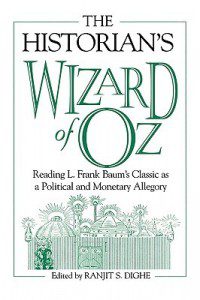Frank Baum’s classic children’s novel The Wonderful Wizard of Oz was published in 1900. He wrote thirteen additional Oz books, and the film adaptation staring Judy Garland was released in 1939. Broadway’s The Wiz opened in 1975 on the seventy-fifth anniversary of the original book.
 I’ve recently been exploring the allegorical interpretations of that mythology through Ranjit Dighe’s The Historian’s Wizard of Oz: Reading L. Frank Baum’s Classic as a Political and Monetary Allegory. The allegorical interpretation did not break into popular consciousness until 1964, when a high school history teacher named Henry Littlefield published an article titled “The Wizard of Oz: Parable on Populism” which invited readers to look beneath the surface story to see a symbolic allegory about U.S. economics and politics in the 1890s, when Baum was writing his book (1).
I’ve recently been exploring the allegorical interpretations of that mythology through Ranjit Dighe’s The Historian’s Wizard of Oz: Reading L. Frank Baum’s Classic as a Political and Monetary Allegory. The allegorical interpretation did not break into popular consciousness until 1964, when a high school history teacher named Henry Littlefield published an article titled “The Wizard of Oz: Parable on Populism” which invited readers to look beneath the surface story to see a symbolic allegory about U.S. economics and politics in the 1890s, when Baum was writing his book (1).
As far as scholars can tell, “Baum left behind no concrete evidence that he wrote the book as a political allegory, and…virtually nobody read it as one until more than sixty years later (x). Baum died in 1919 at age 62, more than four decades too early for anyone to ask him directly about potential monetary symbolism in his writing. Of course, even if authors are still alive, sometimes they misrepresent their intentions to critics for a variety of reasons (42). Moreover, sometimes writers unconsciously incorporate symbols and archetypes into their fiction without intent.
Proponents of the allegorical interpretation see The Wizard of Oz as about the plight of western farmers in the late nineteenth century, who had been economically devastated by deflation (falling prices) in the decades following the Civil War. In 1896, William Jennings Bryan was the presidential nominee for both the Democrats and the People’s (Populist) Party. At the 1896 Democratic National Convention, he delivered his famous “Cross of Gold” speech against the gold standard in which he proclaimed, “You shall not crucify mankind upon a cross of gold.” Instead, on behalf of western farmers, he called for “free silver”—“that the government stamp silver bullion into coins, upon demand, to increase the money supply and end the deflation” (2).
According to the populist allegory, Dorothy of Kansas represents the best traits of farmers from the American West: “honest, kindhearted, plucky.” Thus, it is no coincidence that Dorothy’s farmhouse lands precisely on the Wicked Witch of the East, who is seen as representing the corrupt “Eastern financial and industrial interests,” especially Wall Street (49).
And although Judy Garland wore “ruby slippers” in the first major film version, in both the original novel and in The Wiz, Dorothy wore silver slippers. And what did William Jennings Bryan’s “Cross of Gold” speech call for? “Free silver!” From the populist perspective, financial elites in the East were the ones refusing to incorporate silver into the monetary standard. So here we have a Kansas farm girl, killing the Wicked Witch of the East(ern financial elites), and taking her silver slippers down the yellow (gold!) brick road to the capital city (Oz / Washington, D.C.) where they could petition for permanent change (53). Moreover, the name Oz has been seen as explicitly symbolic of the abbreviation for ounce (oz.), “the unit in which gold and silver were measured” (57).
As Dorothy’s silver-shoed journey continues down the golden, yellow brick road, she begins to acquire traveling companions. First, she meets the Scarecrow, who has been told that he has “no brains” in his straw head (56). Allegorically, he is a literal “straw man,” a stereotype of a supposed dumb rural farmer (56). We come to see, however, that the Scarecrow is quite shrewd and capable (56).
Next, Dorothy meets the Tin Woodsman, symbolic of workers in the lumber industry, who have increasingly been treated less like humans than robots. The Tin Man’s rust symbolizes prolonged unemployment (60-63).
As Dorothy continues down the yellow brick road, she soon encounters her third and final companion for the journey—a lion. Since lion rhymes with Bryan, the lion has been seen as symbolic of William Jennings Brian. In the play, he presents himself as mean, but soon proves to be cowardly.
The full details of the allegorical interpretation go much deeper than I can adequately explore in one post. For now, I will move toward my conclusion by moving to the end of the story. In the end, we discover, along with Dorothy and her friends, that throughout their journey they have many times shown that they already possess the traits they are seeking from the Wizard: courage, intellect, and heart. They don’t need the external validation of some alleged, con man of a wizard. They just need to look inside themselves and trust in their power and talents. Perhaps that too is an allegory for resistance and resilience in our time.
The Rev. Dr. Carl Gregg is a certified spiritual director, a D.Min. graduate of San Francisco Theological Seminary, and the minister of the Unitarian Universalist Congregation of Frederick, Maryland. Follow him on Facebook (facebook.com/carlgregg) and Twitter (@carlgregg).
Learn more about Unitarian Universalism: http://www.uua.org/beliefs/principles












